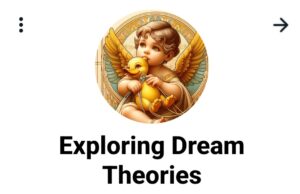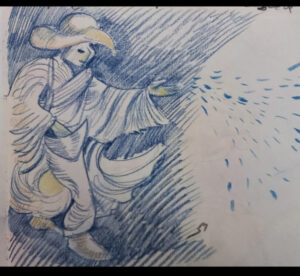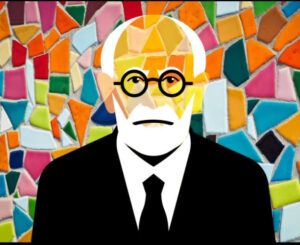Creativity in Dreams – Problem-Solving and Innovation
In Chapter 7 of “Altered States of Dreaming: Structure and Logic,” We expand on the intricate relationship between dreaming and creativity, illustrating how dreams function as potent vehicles for innovation, problem-solving, and artistic exploration. This chapter integrates neuroscience, psychology, and cross-cultural perspectives to unpack how the altered logic of dreams uniquely facilitates creative insight, fostering both individual and cultural innovation.
7.1. Dreams as Creative Laboratories
Dreams provide a cognitive playground, free from the logical constraints of waking reality, allowing the mind to explore possibilities through associative, symbolic, and emotional thought processes.
Key Concepts:
- Associative cognition in dreams allows unprecedented combinations of ideas and images.
- Symbolic thinking in dreams bypasses linear logic, enabling novel insights.
References and Deep Comments:
- Hartmann, E. (1996). “Outline for a Theory on the Nature and Functions of Dreaming.” Hartmann suggests dreams operate through “thin boundaries,” allowing greater flexibility in creative thought.
- 🪢🪢: Our website aligns this theory with modern neuroscience findings on reduced prefrontal inhibition during REM sleep, suggesting dreams naturally facilitate creative breakthroughs by enabling unconventional thought patterns.
7.2. Historical and Artistic Innovations Inspired by Dreams
Throughout history, dreams have significantly influenced major discoveries and artistic creations, showcasing their potential as catalysts for creativity.
Key Examples:
- Dmitri Mendeleev’s periodic table, inspired by a dream.
- Mary Shelley’s “Frankenstein,” conceived from a dream.
References and Deep Comments:
- Barrett, D. (2001). “The Committee of Sleep: How Artists, Scientists, and Athletes Use Dreams for Creative Problem Solving.” Barrett’s extensive catalog of historical anecdotes illustrates how dreams have shaped critical cultural developments.
- 🪢🪢: Our website expands upon Barrett’s collection, hypothesizing that dream-inspired innovations stem from dream logic’s capacity to juxtapose unrelated concepts, enabling groundbreaking discoveries.
7.3. Neurocognitive Foundations of Dream Creativity
Neuroscientific insights reveal how dream states uniquely position the brain for creative problem-solving.
Key Concepts:
- Heightened activity in visual and associative cortex during REM sleep.
- Reduced prefrontal cortex activity, lowering logical constraints.
References and Deep Comments:
- Walker, M. P. (2017). “Why We Sleep: Unlocking the Power of Sleep and Dreams.” Walker’s research demonstrates how REM sleep facilitates emotional processing and memory integration, essential for creative thinking.
- 🪢🪢: Our website connects Walker’s findings to a broader creative process framework, proposing dreams as critical spaces for “emotional incubation,” enhancing creative insight upon awakening.
7.4. Lucid Dreaming and Creative Intentionality
Lucid dreams, characterized by self-awareness within dreams, offer an intentional approach to creativity, allowing dreamers to consciously engage and experiment within their dreams.
Key Concepts:
- Intentional interaction with dream content can foster deliberate creative problem-solving.
- Lucid dreaming as a technique for targeted creativity and artistic exploration.
References and Deep Comments:
- LaBerge, S. (1985). “Lucid Dreaming: The Power of Being Awake and Aware in Your Dreams.” LaBerge’s pioneering work highlights lucid dreaming as a unique cognitive state for creative experimentation.
- 🪢🪢: Our website proposes lucid dreaming techniques as practical tools for artists, scientists, and innovators, enabling deliberate cultivation of dream-based creativity.
7.5. Cultural Perspectives on Dreaming and Creativity
Different cultures have historically recognized and leveraged the creative potential of dreams, embedding dream work into social and artistic practices.
Key Concepts:
- Indigenous cultures often treat dreams as creative resources for communal wisdom and artistic expression.
- Cross-cultural rituals and practices designed to enhance dream creativity.
References and Deep Comments:
- Tedlock, B. (1991). “Dreaming: Anthropological and Psychological Interpretations.” Tedlock’s ethnographic research illustrates how diverse cultures systematically harness dreams for collective creativity.
- 🪢🪢: Our website emphasizes that examining cultural practices provides a broader context for understanding the universal and varied roles dreams play in human creativity.
7.6. Therapeutic Applications: Dreamwork for Creative Healing
Dreamwork is increasingly recognized in therapeutic contexts for its potential to facilitate emotional healing and creative self-expression.
Key Concepts:
- Dreams as emotional outlets and creative narratives aiding psychological integration.
- Therapeutic methodologies incorporating dreams to resolve creative and emotional blockages.
References and Deep Comments:
- Hillman, J. (1979). “The Dream and the Underworld.” Hillman’s archetypal psychology suggests that engaging creatively with dreams can uncover and resolve psychological conflicts.
- 🪢🪢: Our website expands Hillman’s ideas by integrating contemporary neuroscience, arguing that dreams serve therapeutic creativity by allowing the emotional brain to explore novel solutions to emotional and psychological issues.
7.7. Future Directions: Dream Creativity and Technology
Emerging technologies provide new avenues for exploring dream creativity, with virtual reality (VR), artificial intelligence (AI), and neuroimaging offering innovative tools for understanding and enhancing the creative dimensions of dreams.
Key Concepts:
- Neuroimaging techniques to map creative cognitive processes during dreams.
- VR and AI applications for creative exploration and manipulation of dream content.
References and Deep Comments:
- Dresler, M., et al. (2015). “Dreamed Movement Elicits Activation in the Sensorimotor Cortex.” This research demonstrates how neuroimaging can track dream experiences, opening avenues for technologically mediated dream creativity.
- 🪢🪢: Our website suggests future research could harness these technologies to intentionally enhance dream creativity, potentially revolutionizing creative industries and therapeutic practices.
Conclusion of Chapter 7
Our chapter on dreaming and creativity underscores dreams as essential cognitive experiences for fostering innovation, artistic expression, and problem-solving. By integrating historical, neurobiological, cultural, and therapeutic perspectives, the chapter offers a holistic understanding of dream creativity’s profound implications for individual and collective human advancement.




